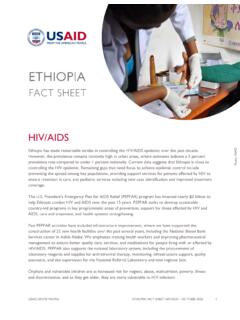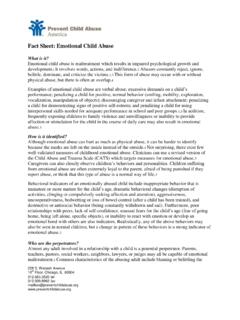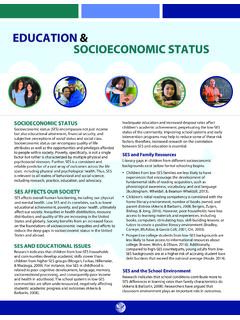Transcription of FACT SHEET THE GENDER WAGE GAP IN CANADA …
1 1 fact SHEET MOVING WOMEN OUT OF poverty Updated: August 2018 The GENDER wage gap is the difference in earnings between women and men in the workplace. It is a widely recognized indicator of women s economic equality, and it exists to some extent in every country in the world. A 2015 UN Human Rights report raised concerns about the persisting inequalities between women and men in CANADA , including the high level of the pay gap and its disproportionate effect on low-income women, racialized women, and Indigenous CANADA is ranked as having the 8th highest GENDER pay gap out of a list of 43 countries examined by the OECD, based on 2016 Note that CANADA is ranked after the European Union, which is listed as a single country, but includes 28 countries. FREQUENTLY ASKED QUESTIONS ABOUT THE GENDER WAGE GAP IN CANADA : 1.
2 How is the wage gap measured? The GENDER wage gap can be typically measured in three different ways. Compare the annual earnings, by GENDER , for both full-time and part-time workers. On this basis, women workers in CANADA earn an average of 69 cents for every dollar earned by men in This measurement results in the largest wage gap because more women work part-time, and part-time workers typically earn less than full-time workers. Compare the annual earnings of full-time workers. On this basis, women workers in CANADA earned an average of 75 cents for every dollar earned by men in Statistics CANADA notes that the measure above doesn t account for the fact that full-time working women tend to work fewer hours than men, often because of family responsibilities. Thus, comparing the hourly wages of full-time working women to those of men provides a more precise picture of the wage gap.
3 On this basis, women earned an average of 87 cents for every dollar earned by men in No matter which calculation is used, the wage gap clearly exists for women in CANADA . fact SHEET THE GENDER WAGE GAP IN CANADA CCANCANADIN CANADA 2 fact SHEET MOVING WOMEN OUT OF poverty Updated: August 2018 2. Is the wage gap the same for all women? No. Although statistical averages are good indicators of how women are being compensated in the workplace, Indigenous, racialized, disabled and newcomer women all experience the wage gap in different ways, for a variety of According to data from the 2016 Census: Indigenous women working full-time, full-year earn an average of 35% less than non-Indigenous men, earning 65 cents to the Racialized women working full-time, full year earn an average of 33% less than non-racialized men, earning 67 cents to the Newcomer women working full-time, full-year earn an average of 29% less than non-newcomer men, earning 71 cents to the According to the 2012 Canadian Survey on Disability, women with a disability in CANADA working full- and part-time earn approximately 54 cents to the dollar when compared to the earnings of non-disabled men, equaling a wage gap of around 46%.
4 10 3. Why does the wage gap exist? One of the most dramatic social changes in the last century has been the increase of women in CANADA s paid work force. In 2015, 82% of women ages 25-54 participated in the workforce, a significant difference from in 1950 and in However, governments and employers have not adequately responded to this new reality, which puts women at an economic disadvantage. The GENDER wage gap is complex and results from a variety of factors: First, traditional women s work pays less than traditional men s work. Jobs that conform to traditional GENDER roles tend to be undervalued because they parallel domestic work that women were expected to perform for Research also suggests that when women make up a large percentage of a specific industry, wages become For example, in CANADA 97% of truck drivers are male and earn a median salary of $45,417 per year.
5 In contrast, 97% of early childhood educators in CANADA are female and earn a median salary of $25,334 per Second, most women workers are employed in lower-wage occupations and lower-paid industries. Women work in a narrower range of occupations than men and have high representation in the 20 lowest-paid In 2015, women workers in CANADA were the most highly represented in three fields (as compared to men): health care and social assistance, educational services, and food and accommodation services. The proportion of women to men in these industries has actually increased since Women also make up the majority of CANADA s minimum-wage workers, and a third of working women make less than $15 per Around 50% of the wage gap is attributed to the fact that women are more likely to be found in lower-paying 3 fact SHEET MOVING WOMEN OUT OF poverty Updated: August 2018 Another factor in the overall wage gap is that more women than men work About three-quarters of part-time workers in 2015 were Women work part-time for several reasons, including lack of affordable child care and family leave policies, along with social pressure to carry the bulk of domestic responsibilities.
6 About 44% of Canadian non-school age children live in childcare deserts , which are areas where at least three children would be in potential competition for each licensed daycare These factors also make it more likely for women to have interruptions or absences from work, which are linked to fewer opportunities for promotions and salary According to Statistics CANADA , of women who were away during the work week listed family responsibilities as the cause, compared with only of A large portion of the wage gap remains unexplained and is partly due to discrimination. An estimated 10-15% of the wage gap is attributed to GENDER -based wage discrimination or other unexplained Wage discrimination and employment discrimination refer to different things. The Pay Equity Act requires employers to ensure men and women receive equal pay for work of equal value.
7 The Employment Equity Act requires that employers remove barriers to the workplace for women, Indigenous people, members of racialized groups, and people with disabilities. In 2018, the federal government acknowledged the factors above as contributors to the wage gap prioritized taking steps to close it in the 2018 Federal Budget. Under the theme of Equality + Growth, the government committed to proactive pay equity for federally regulated sectors. It is estimated that this will affect million Canadians, marking a large step forward on the road to equal pay for federal In April 2018, Ontario was the first province in CANADA to pass pay transparency laws, a significant step toward closing the pay gap. Starting in 2019, the Pay Transparency Act requires that all public job postings include a salary rate or range, and forbids employers from asking about past compensation or disciplining employees who talk about compensation.
8 Additionally, employers with 100 or more employees will be required to track and report pay data, including any GENDER pay gaps within the 4. What is the long-term impact of the wage gap for women in CANADA ? According to an Ontario Government report, women with the same experience, socio-economic and demographic background earn approximately $7,200 less than their male counterparts per Added up annually, this amount has a significant impact on the economic stability of women, decreasing their financial independence and ability to save for retirement . Every year, the Ontario Equal Pay Coalition marks Equal Pay Day, the date when women in the work force have earned the same that men made in the previous year. On average, women must work 15 and a half months to earn what a man does in 12 months.
9 In 2018, Equal Pay Day was held on April Estimates vary, but a 2017 study from the World Economic Forum has stated that it will take around 217 years to close the economic GENDER gap worldwide if present trends 4 fact SHEET MOVING WOMEN OUT OF poverty Updated: August 2018 A 2017 study from the Institute for Women s Policy Research in the United States found that if equal pay were achieved, it would cut working women s poverty levels in 5. Is there a wage gap for well-educated women and those in top positions? The wage gap has not closed, despite the fact that women have begun to outnumber men when it comes to pursuing university degrees. Approximately 56% of post-secondary students in CANADA are Women who graduate university with a bachelor s degree earn an average of $69,063 annually, while men who graduate with a bachelor s degree earn $97, Women today are pursuing demanding careers and moving into management and leadership positions.
10 However, only three out of the 100 highest-paid Canadian CEOs were women in The under-representation of women in top earning positions contributes to slower progress in efforts to close the GENDER pay In Ontario, the highest paid 10% of women still earn 37% less than the highest paid 10% of At all levels of income (except for the very lowest) women earn less than 6. Does the wage gap really matter? Women s lower earning power means they are at a higher risk of falling into poverty if they have children and then become separated, divorced, or widowed. They are less able to save for their retirement and more likely to be poor in their senior years; in fact , women 65 or over are more likely than their male counterparts to live on a low The risk of falling into poverty means that women are sometimes forced to stay in abusive relationships, despite the danger.





